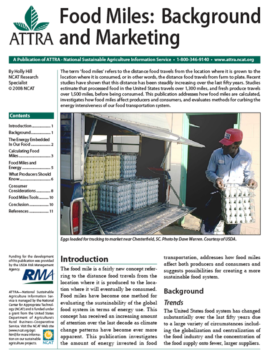Food Miles: Background and Marketing
By Holly Hill, NCAT Research Specialist
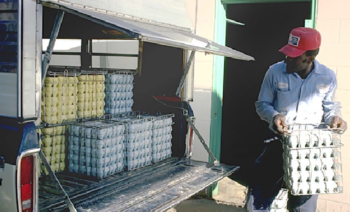
Eggs loaded for trucking to market near Chesterfield, SC. Photo by Dave Warren. Courtesy of USDA.
Abstract
The term food miles refers to the distance food travels from the location where it is grown to the location where it is consumed, or in other words, the distance food travels from farm to plate. Recent studies have shown that this distance has been steadily increasing over the last 50 years. Studies estimate that processed food in the United States travels over 1,300 miles, and fresh produce travels over 1,500 miles, before being consumed. This publication addresses how food miles are calculated, investigates how food miles affect producers and consumers, and evaluates methods for curbing the energy intensiveness of our food transportation system.
Introduction
The food mile is a fairly new concept referring to the distance food travels from the location where it is produced to the location where it will eventually be consumed. Food miles have become one method for evaluating the sustainability of the global food system in terms of energy use. This concept has received an increasing amount of attention over the last decade as climate change patterns have become ever more apparent. This publication investigates the amount of energy invested in food transportation, addresses how food miles affect both producers and consumers and suggests possibilities for creating a more sustainable food system.
Background
Trends
The United States food system has changed substantially over the last 50 years due to a large variety of circumstances including the globalization and centralization of the food industry and the concentration of the food supply onto fewer, larger suppliers.
A report released in 1998 by the USDA found that 80% of the meat industry is controlled by only four firms.(1) In his essay entitled “Food Democracy,” Brian Halweil states that half of the food items in a typical supermarket are produced by no more than 10 multinational food and beverage companies.(2) The majority of food consumed today passes through a complex, indirect network of a few large, centralized producers, processors, transporters and distributors before reaching the consumer.
An additional change in the food system is the increasing trend of these multinational firms sourcing food from outside of regional, state and even national boundaries in order to provide consistent products at low prices. Figure 1 illustrates the steady increase in world agricultural trade between 1961 and 2000.(3)
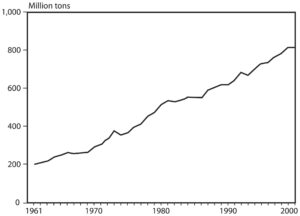
Figure 1. Volume of World Agricultural Trade, 1961-2000. Source: Brian Halweil. Home Grown: The Case for Local Food in a Global Market. 2002.
The development of global food transport systems has resulted in higher consumer expectations. Consumers now have the ability to choose from a wide variety of food items, regardless of the season or their location, all at a low price.
The ability to enjoy consistent produce and exotic ingredients at all times of the year is a luxury that, according to many food system analysts, has its price. The farther food travels and the longer it takes en route to the consumer, the more freshness declines and the more nutrients are lost. Many fruits and vegetables are engineered for a long shelf life, sacrificing taste and nutrition for preservation.
As large multinational companies gain control over the food industry, small local farmers suffer. Since 1979, 300,000 farmers have gone out of business and those remaining are receiving 13% less for every consumer dollar for farm goods.(1) Large distributors are able to drive prices down on imported goods, forcing many small farms to either export their crop as a raw commodity or replace regional crops with something more profitable. For example, in 1870 100% of the apples consumed in Iowa were produced in Iowa. By 1999, Iowa farmers grew only 15% of the apples consumed in the state.(4) This phenomenon limits the potential for local self-sufficiency and increases dependency on outside sources.
Changes in the food system have resulted in a broad range of social and economic implications, but the present food system also has an environmental cost. The farther food travels, the more fossil fuels are required for transport. The burning of fossil fuels leads to the emission of greenhouse gases, which contribute to global warming. The following sections will investigate the extent to which food miles contribute to high energy consumption levels and CO2 emissions.
The Energy Embedded in Our Food
The Carbon Footprint of the Food System
While studies vary, a typical estimate is that the food industry accounts for 10% of all fossil fuel use in the United States.(5) Of all the energy consumed by the food system, only about 20% goes towards production; the remaining 80% is associated with processing, transport, home refrigeration, and preparation.
Recent research at the University of Chicago has investigated the energy consumption of the food system and compared it to the energy consumption associated with personal transportation in the United States. Personal transportation is often recognized as a major contributor to greenhouse gas emissions, as evident in the movement towards higher efficiency vehicles. This study found, however, that the average American uses between 170 and 680 million BTUs of energy in personal transportation annually and roughly 400 million BTUs in food consumption.(6) The food industry accounts for a considerable portion of energy consumption in the United States and merits closer evaluation.

Figure 2. Transportation accounts for 14% of energy use within the food system. Source: Heller and Keoleian. Life Cycle-Based Sustainability Indicators for Assessment of the U.S. Food System. 2000.
According to one study, food transportation accounts for 14% of energy use within the food system. Figure 2 demonstrates the energy use required for each step of the food industry process.(7) Food miles, although a fraction of the U.S. energy consumption as a whole, remain a considerable source of carbon emissions, especially when considering that the United States is the single largest emitter of greenhouse gases in the world, accounting for 23% of the global total at nearly 1,600 million metric tons annually.
The U.S. food system alone uses as much energy as France’s total annual energy consumption.(8)
Calculating Food Miles
How Far Does Food Travel?
The Leopold Center for Sustainable Agriculture has been the leading researcher of food miles in the United States and has conducted several studies comparing the distance food travels if it is sourced locally rather than conventionally. A 1998 study examined the distance that 30 conventional fresh produce items traveled to reach the Chicago Terminal Market.
The Leopold Center found that only two food items, pumpkins and mushrooms, traveled less than 500 miles. Six food items including grapes, lettuce, spinach, broccoli, cauliflower and green peas traveled over 2,000 miles to reach the Chicago market. The average distance traveled amounted to 1,518 miles.(9) Figure 3 shows the distance that select produce items traveled before reaching their destination at the Chicago Terminal Market.
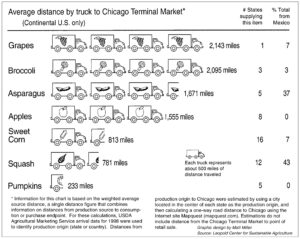
Figure 3. Distance Produce Traveled to Reach Chicago Market. Source: Leopold Center for Sustainable Agriculture
Another study conducted in the Waterloo Region of Southwestern Ontario investigated the food miles associated with 58 commonly eaten, imported foods. The study found that each food item traveled an average of 4,497 kilometers or 2,811 miles, producing 51,709 tons of greenhouse gas emissions annually.(10)
These calculated distances don’t include the distance consumers travel to shop for food or the distance that waste food travels to be disposed of. It is apparent that food is traveling long distances, but the extent to which food miles have an effect on the environment is more complex. The following sections will cover the formulas used to calculate food miles and investigate the energy involved in the transportation of food.
How Are Food Miles Calculated?
A series of formulas for calculating food miles has been developed and has become widely accepted. Calculating the distance a food item has traveled varies in complexity depending on whether the item is made up of a single ingredient or multiple ingredients and the mode of transportation used to carry the item.
The Weighted Average Source Distance (WASD) formula was developed by Annika Carlsson-Kanyama in 1997 and takes into account the amount of food transported in weight and the distance that it travels from the place of production to the place of sale. Fruits and vegetables and other items consisting of only one ingredient would utilize the WASD formula for calculating food miles.
The Weighted Total Source Distance (WTSD) formula was developed by the Leopold Center for Sustainable Agriculture and accounts for multiple-ingredient foods by calculating the weight and distance traveled for each ingredient. Foods like flavored yogurt, bread, and other processed foods would employ the WTSD formula for calculating food miles.
While both WASD and WTSD convey an estimate of the distance food travels between the producer and consumer, neither formula addresses greenhouse gas emissions associated with this distance traveled. The Weighted Average Emissions Ratio (WAER) formula takes into account both distance and the associated greenhouse gas emissions for different modes of transportation. This formula was developed by the nonprofit organization LifeCycles, in 2004.
For detailed information about food miles formulas and calculating food miles, see the Leopold Center’s publication, Calculating Food Miles for a Multiple Ingredient Food Product.
Mode of Transportation
As suggested by the Weighted Average Emissions Ratio formula, the mode by which food is transported is an important factor when considering the environmental impact of food miles. A food item traveling a short distance may produce more CO2 than an item with high food miles, depending on how it is transported.

Figure 4. Energy use and emissions for different modes of freight transport. Source: Transport for a Sustainable Future: The Case for Europe.(11)
Figure 4 contains the estimated values of energy consumption and greenhouse gas emissions for four different transportation modes measured in the UK.(11) Air transportation is, by far, the most energy intensive means of transporting food and other goods.
A study released in the UK in 2005 found that air transport is the fastest growing mode of food distribution and although air transport accounts for only 1% of food transport in the UK, it results in 11% of the country’s CO2 emissions. The UK report also estimated that the social and economic costs of food transport including accidents, noise and congestion amount to over 9 billion British pounds every year or 18 billion American dollars.(12)
Food Miles and Energy
Is Local Food Less Energy Intensive?
Proponents of reducing food miles often suggest that buying local food will reduce the amount of energy involved in the transportation process, as food sourced locally travels shorter distances. The Leopold Center for Sustainable Agriculture has conducted several studies that compare the distance traveled by conventional versus local foods. Figure 5, compiled by the Leopold Center, compares food miles for local versus conventional produce traveling to Iowa. In all cases, the locally grown food travels a significantly shorter distance than the conventionally sourced food.
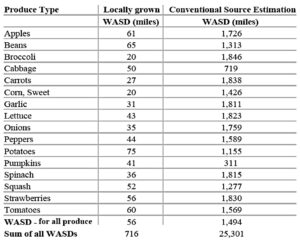
Figure 5: Food miles for local versus conventional produce.
Source: Leopold Center for Sustainable Agriculture.e
Another study conducted by the Leopold Center in 2001 investigated the distance that food traveled to institutional markets such as hospitals and restaurants in Iowa using three different food sources: conventional, Iowa-based regional and Iowa-based local. The study found that food sourced from the conventional system used 4 to 17 times more fuel than the locally sourced food and emitted 5 to 17 times more CO2.(4) The Leopold Center used this information to estimate the distance, fuel consumption and CO2 emissions that could potentially be saved by replacing 10% of the Iowa’s current food system with regional or locally sourced food. This information is displayed in Figure 6. It is interesting to note that when the transportation method was taken into account, the local food system required more energy and emitted more CO2 than the regional system. This is because the trucks supplying food locally had a smaller capacity, therefore requiring more trips and logging more miles.
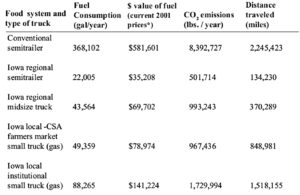
Figure 6: Estimated fuel consumption, CO2 emissions and distance traveled for conventional, Iowa-based regional, and Iowa-based local food systems for produce. Source: Leopold Center for Sustainable Agriculture
It has been shown that local food systems do reduce food miles, which in turn tend to reduce energy consumption, but there are exceptions. Local transportation systems may not always be as efficient as regional systems, depending on the mode of transport and load capacity.
Does Reducing Food Miles Reduce Energy Use?
A Japanese group, Daichio-Mamoru Kai (The Association to Preserve the Earth) conducted a study that found that a typical Japanese family could reduce their CO2emissions by 300 kilograms annually by eating locally.(13) The Canadian Waterloo Region study mentioned above estimated that sourcing the 58 food items in the study locally and regionally rather than globally could reduce greenhouse gas emissions by 49,485 tons annually. This is the equivalent of removing 16,191 vehicles from the road.(11)
The food miles issue becomes even more complex when considering factors besides distance traveled and mode of transportation. The energy required to grow some foods in unsuitable climates may override the energy of transporting food from locations where the food is more easily grown. For example, a Swedish study found that tomatoes traveling from Spain to Sweden were less energy intensive than tomatoes raised in Sweden, because of the process by which they were grown. The Spanish tomatoes were raised in the open ground, while the Scandinavian climate required tomatoes to be raised in heated greenhouses utilizing more fossil fuels.(4)
A New Zealand report found that exporting some foods to the UK consumes less energy than producing the same food in the UK because the agricultural system in New Zealand tends to use less fertilizer and raises year round grass-fed livestock, which uses less energy than housing and feeding animals.(14)
The UK Department for Environment, Food and Rural Affairs (DEFRA) released a report in 2005, which determined that food miles alone are not a valid indicator of the sustainability of the food system. In some cases, reducing food miles may reduce energy use, but there may be other social, environmental or economic trade-offs. The consequences of food transport are complex and require a group of indicators to determine the global impact of food miles.(13)
Life Cycle Assessment
There is increasing significance in considering all stages of energy consumption in the food system. Many organizations have investigated the idea of life-cycle-based analysis to determine the sustainability of the food system.
Life cycle assessment (LCA) is a method used to analyze the consumption and environmental burdens associated with a product. LCA takes into account energy input and output involved in all stages of the life cycle including production, processing, packaging, transport and retirement. Life cycle evaluation accounts for a matrix of sustainability indicators beyond greenhouse gas emissions, including resource depletion, air and water pollution, human health impacts and waste generation. This method provides a more holistic approach to assessing the impact our food choices have on the environment.(7)
Life cycle assessments of various conventional food products have found that the current food production and consumption patterns are unsustainable.(15) Adopting a “life cycle thinking” approach to food consumption would be a productive method for increasing the sustainability of the food system.
What Producers Should Know
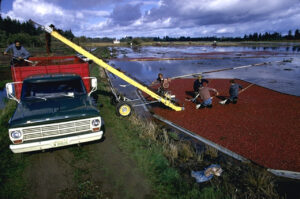
Cranberries loaded on truck for shipment. Photo by Earl J. Otis, USDAC
Marketing
For producers, reducing food miles means selling products to a more local or regional market. While, this may be an intimidating prospect for farmers who have no experience with alternative markets, the opportunities are significant and diverse, including farmers’ markets, CSAs and farm-to-institution programs, all of which are looking for local producers. The following sections briefly examine some of the markets and methods available for a producer looking to reduce the energy involved in transporting food.
Direct Marketing
Direct marketing allows farmers to compete with wholesale market channels and mass supermarket systems, thereby creating a local food network and reducing the distance that food travels. Direct marketing networks could include farmers’ markets, wholesale food terminals and community-supported agriculture. The ATTRA publication Direct Marketing offers information about alternative marketing systems, with an emphasis on value-added crops.
Farmers Markets and CSAs
Selling produce at farmers’ markets is one alternative marketing strategy available for producers. By removing brokers from the distribution chain, farmers are able to reap a greater profit. Farmers’ markets also benefit community interaction and economic development. For more information about how to join or start a farmers’ market successfully, see the ATTRA publication Farmers Markets: Marketing and Business Guide.
Community supported agriculture (CSA) offers another option for marketing to a local or regional clientele. CSAs typically have members that are “share-holders” in the farm, paying for the anticipated costs of the farm operation. The ATTRA publication Community Supported Agriculture contains information about production considerations and using the Internet as a means of information dissemination to members.
The number of farmers’ markets and CSAs has grown substantially over the last decade indicating both the potential of success for the farmer and the growing demands of consumers for fresh, local food.
Farm-to-Institution Programs
Selling food directly to schools, hospitals, prisons and other institutions is becoming an increasingly popular option. Selling food to institutions creates a reliable market for the farmer and provides great health and economic benefits to the consumer. Farm-to-institution programs also reduce food miles. The University of Montana’s Farm to College program estimated that replacing a year’s supply of conventionally sourced hamburgers and French fries with local ingredients saved 43,000 gallons of fuel and the associated greenhouse gasses from being emitted.(16)
Ecolabels
Ecolabels offer one method for educating consumers about locally grown, sustainably raised foods, and have proven effective in product marketing. An ecolabel is a seal or a logo indicating that a product has met a certain set of environmental and/or social standards or attributes.
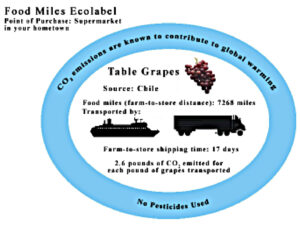
Food miles ecolabel example. Source: Leopold Center for Sustainable Agriculture
The Leopold Center for Sustainable Agriculture has researched the impact that labeling food with ecolabels containing information such as food miles and CO2 emissions has on consumers. The study aimed to determine consumer opinion of locally produced food and food miles. Surveys found that consumers were more responsive to labels that focused on the food product’s freshness and quality rather than environmental impact or CO2 emissions. Consumers perceive that locally grown food is fresher; therefore ecolabels that contain information such as “locally grown by family farmers” may be effective in influencing consumer food choices. The study also found that consumers are willing to pay more for food that has low environmental impacts.(17) Figure 7 is an example of a food label containing food miles information.
The Western Montana Sustainable Growers Union is a group of 12 Missoula-area organic farms that has developed the “Homegrown” label, which informs consumers that the food item they are purchasing was grown within 150 miles. Producers in the group pledge “to grow naturally, protect air and water, maintain fair labor practices and, most importantly, to sell and buy in their communities.” Groups such as this are jumping up across the country and having an impact on their markets.(18)
Consumer Considerations
Consumer Demand
Producers may question the extent to which consumers are using food miles as a basis for their food choices. In general food choices are no doubt based on price, taste and appearance and a large section of the public knows and cares little about climate change, especially with regard to food choices.(19)
There has been increasing demand for food produced in accordance with ethical and environmental standards, however, such as organic and fair trade. Food mile concerns may grow as well. Increasing food security and the domestic supply chain may be other arguments for reducing food miles.
Why Consumers Should Care About Food Miles
For consumers, convenience and cost are often driving factors when purchasing food. The choices consumers make, however, can have a great deal of influence on the direction our food system is headed. Reducing the energy intensiveness of our food has several economic, social and environmental benefits. Consumers who are reducing their food mile footprint:
- Enjoy fresher, healthier food
- Support local farmers
- Keep their money in the community
- Know where their food comes from
- Reduce their carbon footprint
Diet and Energy
Buying local and regional food is just one of many dietary choices with important environmental consequences. The FAO estimates that livestock are responsible for 18% of global greenhouse gas emissions.(20) A study at the University of Chicago compared the energy consumption associated with animal-based diets versus plant-based diets and found that consuming a typical American diet of both animals and plants results in 1,485 kg more CO2 than a diet based on plant sources only.
This study concludes that “For a person consuming a red meat diet at 35% of calories from animal sources, the added GHG burden above that of a plant eater equals the difference between driving a Camry and an SUV. These results clearly demonstrate the primary effect of one’s dietary choices on one’s planetary footprint, an effect comparable in magnitude to the car one chooses to drive.”(6)
Local vs. Organic
There has been a great amount of public interest over the last few years in organic food systems. This is an indication of consumers’ increasing awareness of where their food is coming from. Organic food is grown without synthetic fertilizers or pesticides. Since these chemicals are usually made from natural gas and other fossil fuels, through a highly energy-intensive process, eliminating synthetic fertilizer and pesticides can significantly reduce the amount of energy required for production. However, increased demand for organics has resulted in retailers sourcing organically grown food from around the globe, creating increased emissions in the transportation process. Some locally grown nonorganic foods may be less energy intensive than organic foods traveling long distances.
When evaluating our food options, the decisions are complex, especially if you want to make sustainable choices. Local, organic, fair-trade and other forms of sustainably produced food all play a role in creating sustainable food consumption patterns. The following table provides some guidelines for making ethical food decisions.
Table 1. What individuals can do to reduce food miles.
Adapted from Brian Halweil’s Home Grown: the Case for Local Food in a Global Market. 2002.
- Learn what foods are in season in your area and try to build your diet around them.
- Shop at a local farmers market. People living in areas without a farmers’ market might try to start one themselves, linking up with interested neighbors and friends and contacting nearby farmers and agricultural officials for help. People can do the same with CSA subscription schemes.
- Eat minimally processed, packaged and marketed food. Generally speaking, the less processing and packaging you see, the less energy went into production and marketing, the less global warming pollution was created.
- Ask the manager or chef of your favorite restaurant how much of the food on the menu is locally grown, and then encourage him or her to source food locally. Urge that the share be increased. People can do the same at their local supermarket or school cafeteria.
- Consolidate trips when grocery shopping. Consider carpooling, public transportation, or a bike trailer for hauling groceries to reduce your personal contribution to food miles.
- Take a trip to a local farm to learn what it produces.
- Limit the amount of meat you consume and when you do buy meat, look for organic or free-range meat produced on sustainable farms.
- Produce a local food directory that lists all the local food sources in your area, including CSA arrangements, farmers’ markets, food co–ops, restaurants emphasizing seasonal cuisine and local produce, and farmers willing to sell direct to consumers year-round.
- Buy extra quantities of your favorite fruit or vegetable when it is in season and experiment with drying, canning, jamming, or otherwise preserving it for a later date.
- Plant a garden and grow as much of your own food as possible.
- Speak to your local politician about forming a local food policy council to help guide decisions that affect the local foodshed.
Food Miles Tools
Food Carbon Emissions Calculator
This calculator allows users to calculate the carbon emissions related to your food choices, including transportation, waste, and quantity.
Food Carbon Footprint Calculator
A tool for residents within the UK to calculate their food carbon footprint to better understand the extent to which food decisions impact global warming.
LCA Food Database
A tool for acquiring an aggregated description of emissions, waste and the resource use from soil to kitchen per unit of different food items.
Iowa Produce Market Potential Calculator
This calculator was designed to help users determine expanding markets in Iowa if consumers ate more locally grown fresh fruits and vegetables rather than produce from conventional sources outside the state.

Truck on highway near Petersburg, West Virginia. Photo: Ken Hammond, USDA
Conclusion
Food miles are a growing cause of concern due to the greenhouse gas emissions released through the transportation of our food—and rightly so, as food miles consume a considerable amount of energy. However, we must consider the many complexities of the food system besides just the distance our food is traveling. Other important issues include the mode of transportation, the production method, and packaging considerations, as well as our own personal dietary choices. Each consumer food decision provides an opportunity to make a difference (large or small) in the way energy is used and greenhouse gases are emitted. At the same time, growing consumer interest in local and regional foods is creating new marketing opportunities and new possibilities for partnerships with agricultural producers.
Food Miles: Background and Marketing
By Holly Hill
NCAT Research Specialist
IP312
Slot 311
© NCAT
This publication is produced by the National Center for Appropriate Technology through the ATTRA Sustainable Agriculture program, under a cooperative agreement with USDA Rural Development. This publication was also made possible in part by funding from the USDA Risk Management Agency. ATTRA.NCAT.ORG.
Related Publications
Click here to add your own text

